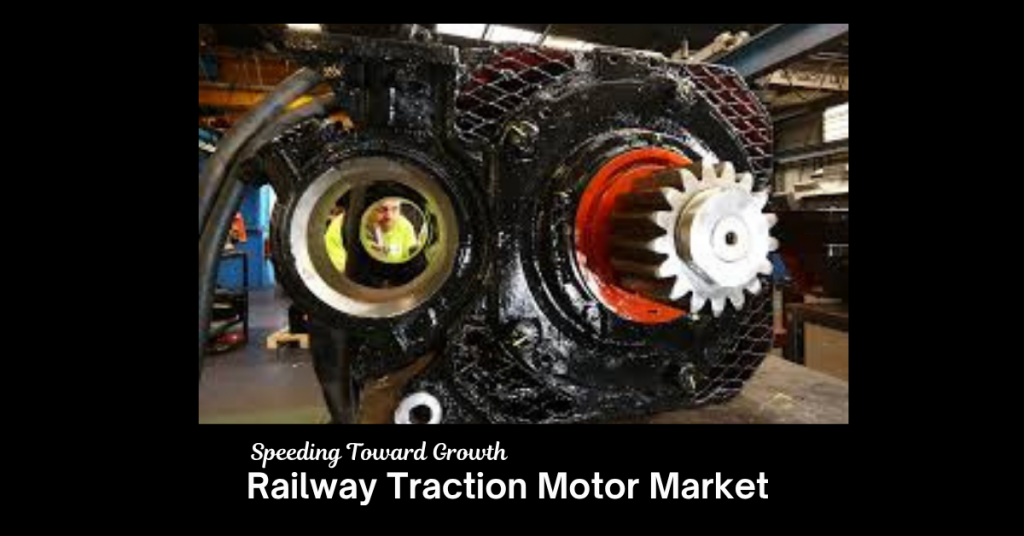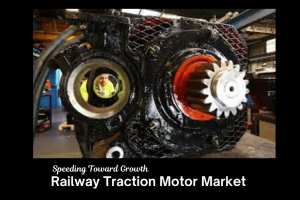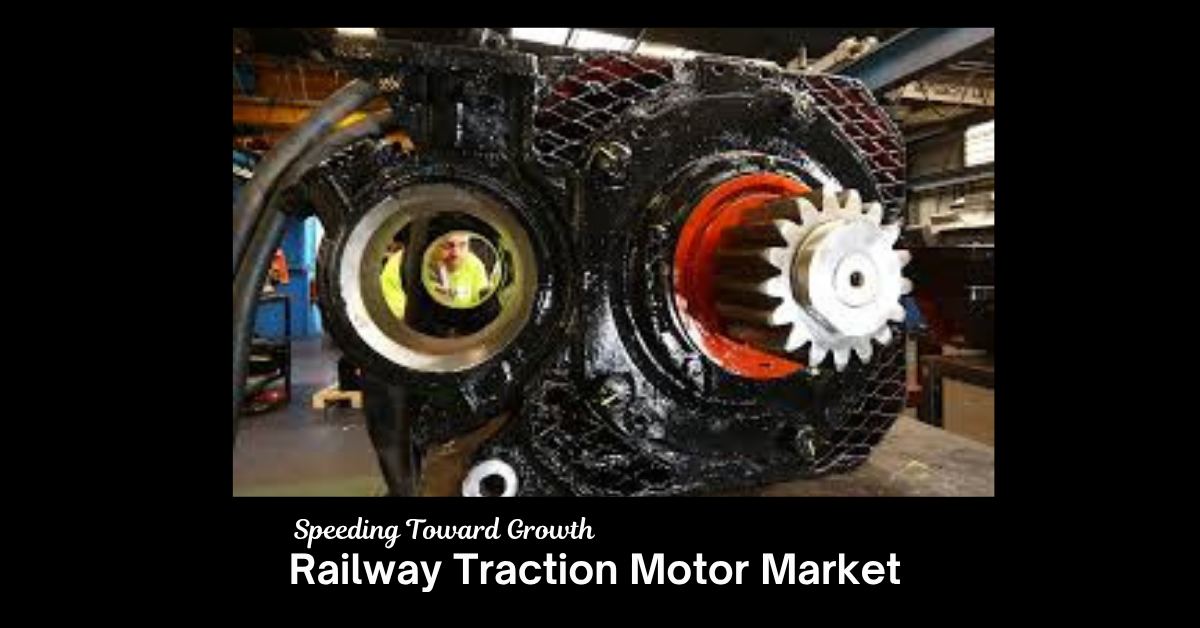
Market Overview
The Railway Traction Motor Market has experienced consistent growth, reaching USD 11,844.04 million in 2024 from USD 8,429.49 million in 2018 and is projected to hit USD 18,352.56 million by 2032, reflecting a CAGR of 5.24% during the forecast period. This surge is largely attributed to growing rail electrification projects, environmental sustainability policies, and modernization of public transport networks worldwide.
Railway traction motors are integral to converting electrical energy into mechanical movement in locomotives. As countries strive to reduce transportation-related emissions, the shift from diesel to electric trains has intensified, driving demand for high-efficiency traction motors. Furthermore, increasing investments in high-speed and light rail projects have enhanced the importance of compact, durable, and energy-efficient motor solutions.
The role of railway traction motors is not just limited to transport efficiency—they also represent a larger commitment toward sustainable infrastructure. Emerging economies are upgrading old fleets, while developed nations are deploying cutting-edge systems. These factors are generating opportunities for manufacturers to innovate and customize motors according to specific geographic and operational needs. With decarbonization at the core of future transport goals, traction motors have become a critical part of next-gen rail systems.
Read full report: https://www.credenceresearch.com/report/railway-traction-motor-market
Market Drivers
Growing Urbanization and Public Transit Expansion
Urban population growth is compelling governments to expand metro and suburban rail networks. Modern cities are relying heavily on rapid transit systems to reduce traffic congestion and pollution. This has led to rising demand for traction motors that can support frequent starts, stops, and quick acceleration. Metro systems across Asia, Europe, and North America are investing in energy-efficient motor systems. These motors offer enhanced thermal management and minimal noise—ideal for densely populated urban routes. Public investment in smart transportation is directly benefiting traction motor innovation and adoption.
Advancements in Motor Design and Efficiency
Traction motors have evolved significantly with the adoption of permanent magnet synchronous motors (PMSM), which offer better efficiency and torque density. Manufacturers are also introducing integrated cooling systems and modular architecture to reduce weight and improve installation flexibility. Materials science improvements have allowed the use of better laminations and magnetic alloys. Innovations in sensorless vector control are further enhancing real-time responsiveness. These factors contribute to a longer product life cycle, reduced maintenance needs, and increased reliability under varying operational conditions.
Electrified Freight Corridors
Several nations are prioritizing the development of electrified freight corridors to reduce carbon footprints and improve long-haul transport efficiency. Heavy-duty locomotives require durable, high-torque traction motors capable of handling extreme loads over long distances. Dedicated freight corridors in India, high-capacity rail routes in China, and U.S. electrification proposals are examples of this trend. These projects demand specialized traction motors designed for cargo reliability and energy recovery. The integration of regenerative braking further amplifies energy efficiency in electric freight locomotives.
Environmental Regulations and Energy Policies
Stringent environmental norms and global climate agreements are pushing railway operators to invest in electric traction systems. Policies supporting the phasing out of diesel engines are widespread across Europe and increasingly visible in parts of Asia and the Americas. Energy efficiency targets under frameworks like the European Green Deal and Sustainable Development Goals (SDGs) are accelerating demand for advanced traction technologies. Regulatory bodies are also offering financial incentives to encourage adoption. As a result, OEMs are focusing on cleaner, low-noise, and energy-saving motor systems.
Market Challenges
High Customization Requirements
Railway systems across countries differ in voltage specifications, operating environments, and load patterns. This leads to a high degree of customization in traction motor design. Manufacturers must meet specific local or project-based requirements, which increases development time and cost. The need for unique configurations often limits mass production efficiencies. Complex engineering and coordination with rail vehicle OEMs can further slow deployment schedules. Tailored solutions, though effective, pose scalability challenges for global players.
Limited Modernization in Low-Income Regions
While developed countries are advancing in rail electrification, several regions in Africa, Southeast Asia, and Latin America still depend on outdated diesel systems. Lack of investment and poor infrastructure delay traction motor deployment in these markets. Donor-driven projects often have limited scope or long gestation periods. Without robust government policy support, modernization efforts remain inconsistent. These gaps in global adoption hinder market penetration for leading players.
Technological Obsolescence Risk
As traction motor technologies evolve rapidly, older models become obsolete sooner than expected. This creates pressure on manufacturers and rail operators to continually upgrade or replace existing systems. Shorter product life cycles increase lifecycle costs. Technological redundancy may lead to inventory challenges and higher operational expenses. Ensuring backward compatibility with existing rail systems becomes an engineering hurdle. Players who fail to innovate risk being edged out by competitors with next-gen offerings.
Skilled Workforce and Maintenance Gaps
The deployment and upkeep of modern traction motors require a skilled technical workforce. However, training gaps and limited technical expertise in several markets lead to operational inefficiencies. Misalignment in handling new motor systems can cause safety and performance issues. OEMs are often burdened with training responsibilities and post-installation support. A lack of qualified personnel also affects preventive maintenance, reducing overall motor performance over time.
Market Opportunity
Expansion of Cross-Border Rail Infrastructure
Global initiatives to connect trade routes through rail corridors—such as the Belt and Road Initiative—are increasing cross-border rail connectivity. These infrastructure projects require large-scale deployment of advanced traction motors compatible with international standards. As interoperability improves, so does the opportunity to sell standardized, scalable motor solutions. OEMs can gain from long-term contracts on multi-country railway networks. This trend supports consistent revenue pipelines and collaborative R&D.
Shift Toward Smart and Autonomous Rail Systems
With digitization spreading across transportation, the railway sector is investing in intelligent rail systems. Autonomous trains and smart locomotives require traction motors integrated with real-time data monitoring and control systems. This shift is creating a new niche for sensor-rich motors that support communication with central rail management platforms. OEMs that offer such digitally connected traction solutions can tap into emerging automation-driven rail projects. Smart features also add a value layer, encouraging higher margins.
Rehabilitation and Retrofitting Projects
Instead of replacing entire locomotives, many rail operators are opting to retrofit older engines with efficient traction motors. This cost-effective strategy is popular in cost-sensitive regions and aging networks. The retrofitting market allows suppliers to offer motor kits compatible with existing setups. Shorter procurement timelines and lower CAPEX requirements make retrofits attractive. This niche is likely to grow, especially in regions balancing modernization with budget constraints.
Growth in Low-Emission Commuter Rail Systems
Electric commuter rails are expanding in medium-density cities that previously relied on buses and taxis. These new electric trains require low-noise, lightweight, and fast-response traction motors to operate within urban and suburban areas. Demand is rising for compact motor formats with easy maintenance and low energy use. Commuter rail expansion, especially in Southeast Asia and Eastern Europe, provides scalable opportunities. OEMs can tailor offerings to the specific operational needs of daily mass transit.
Market Segmentation
Based on Product:
- DC Traction Motor
- AC Traction Motor
- Synchronous AC Traction Motor
Based on Application:
- Diesel Locomotive
- Electric Locomotive
- Diesel-Electric Locomotive
Based on Geography:
North America
- U.S.
- Canada
- Mexico
Europe
- UK
- France
- Germany
- Italy
- Spain
- Russia
- Belgium
- Netherlands
- Austria
- Sweden
- Poland
- Denmark
- Switzerland
- Rest of Europe
Asia Pacific
- China
- Japan
- South Korea
- India
- Australia
- Thailand
- Indonesia
- Vietnam
- Malaysia
- Philippines
- Taiwan
- Rest of Asia Pacific
Latin America
- Brazil
- Argentina
- Peru
- Chile
- Colombia
- Rest of Latin America
Middle East & Africa
- GCC Countries
- South Africa
- Rest of the Middle East and Africa
Regional Analysis
North America
The traction motor market in North America is largely driven by freight demand and metro expansions. The U.S. government’s infrastructure initiatives are creating new opportunities for rail system electrification. Canada is also investing in intercity high-speed rail projects, which support demand for synchronous AC motors. Innovations in cold-weather traction motor performance are being trialed. Rail manufacturers in Mexico are increasingly contributing to North American component exports. The region’s focus remains on modernization and logistics efficiency.
Europe
Europe leads the world in rail system electrification and innovation. The EU’s emphasis on climate-friendly transportation fuels investments in green locomotives and light rail projects. Countries like the UK, Italy, and the Netherlands are upgrading commuter trains with advanced motor systems. EU-backed funding supports local OEMs developing carbon-neutral transport solutions. Hydrogen train pilots in Germany and battery-powered trams in Spain are creating room for new motor specifications. Europe remains a core region for traction motor R&D and early adoption.
Asia Pacific
Asia Pacific accounts for the largest share of traction motor consumption. China’s dominance in high-speed rail and India’s massive electrification agenda fuel constant demand. Japan is a technological leader in motor design, while South Korea contributes to export-led growth. ASEAN countries are increasingly building light rail and MRT systems. Public-private rail projects across Southeast Asia offer diverse application areas. The region’s manufacturing scale and political focus on mass transit make it highly attractive for long-term investments.
Latin America
Latin America is gaining traction as a future market, with a renewed focus on upgrading rail assets. Brazil’s suburban and cargo rail networks are being electrified to meet trade and urban mobility needs. Argentina and Peru are collaborating with global OEMs for modernization projects. Local assembly of motors is being considered to reduce import dependence. With proper funding and technology access, this region could become a high-growth zone. Urbanization and port-rail integration remain the primary market drivers.
Middle East & Africa
Railway traction motor demand in the Middle East is propelled by urban metro systems in Saudi Arabia, UAE, and Qatar. Africa, on the other hand, is seeking to rebuild its fragmented railway networks with international support. Countries like Kenya and Egypt are upgrading with Chinese and European partnerships. Mining logistics and energy exports in sub-Saharan Africa require robust freight rail infrastructure. These developments present untapped opportunities for AC and DC traction motor applications. Growth may be slower but offers long-term stability.
Top Companies
- ABB Ltd.
- Alstom SA
- Mitsubishi Electric Corporation
- Siemens AG
- Hitachi Ltd.
- Sulzer Ltd.
- Hyundai Rotem Company
- CG Power and Industrial Solutions Limited (Murugappa Group)
- VEM Group
- Saini Group
Future Outlook
- Governments will continue investing in railway electrification across urban and rural routes.
- AI-driven predictive maintenance tools will enhance traction motor uptime and efficiency.
- Hydrogen-powered locomotives will gradually shift from pilot to commercial stages.
- Smart city transport planning will boost metro rail and traction motor demand.
- Standardized traction motor platforms will reduce customization costs.
- Battery-electric hybrid traction motors will enter mainstream rail usage.
- Cross-industry collaborations will accelerate R&D in motor performance materials.
- Southeast Asia and Africa will become active consumer bases post-2027.
- Urban freight rail systems will emerge, requiring unique motor designs.
- Digital twin technology will be standard for testing and optimizing motor systems.
Read full report: https://www.credenceresearch.com/report/railway-traction-motor-market


